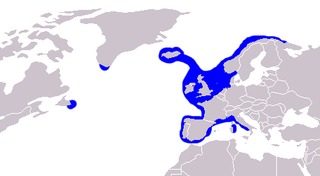
The European sprat, also known as brisling, brisling sardine, bristling, garvie, garvock, Russian sardine, russlet, skipper or whitebait, is a species of small marine fish in the herring family Clupeidae. Found in European, West Asian and North African waters, it has silver grey scales and white-grey flesh. Specific seas in which the species occurs include the Irish Sea, Black Sea, Baltic Sea and Sea of the Hebrides. The fish is the subject of fisheries, particularly in Scandinavia, and is made into fish meal, as well as being used for human consumption. When used for food it can be canned, salted, breaded, fried, boiled, grilled, baked, deep fried, marinated, broiled, and smoked.

The common ling, also known as the white ling or simply the ling, is a large member of the family Lotidae, a group of cod-like fishes. It resembles the related rocklings, but it is much larger and has a single barbel. This species is unrelated to the pink ling, Genypterus blacodes, from the Southern Hemisphere. The common ling is found in the northern Atlantic, mainly off Europe, and into the Mediterranean Basin. It is an important quarry species for fisheries, especially in the northeastern Atlantic, although some doubts exist as to the sustainability of the fisheries. As an edible species, it is eaten fresh, frozen, or dried, but also preserved in lye, while the roe is a delicacy in Spain.

The giant oarfish is a species of oarfish of the family Regalecidae. It is an oceanodromous species with a worldwide distribution, excluding polar regions. Other common names include Pacific oarfish, king of herrings, ribbonfish, and streamer fish.

Chromis chromis, the damselfish or Mediterranean chromis, is a small species of ray-finned fish of the family Pomacentridae from the Eastern Atlantic and Mediterranean.

Apogon imberbis, the cardinalfish, the Mediterranean cardinalfish or king of the mullets, is a species of ray-finned fish, a cardinalfish belonging to the family Apogonidae. It is widely distributed in the Mediterranean and along the warm temperate and tropical eastern Atlantic coasts from Portugal south to the Gulf of Guinea.

The black scorpionfish, also known as the European scorpionfish or small-scaled scorpionfish, is a venomous scorpionfish, common in marine subtropical waters. It is widespread in the Eastern Atlantic Ocean from the British Isles to the Azores and Canary Islands, near the coasts of Morocco, in the Mediterranean Sea and the Black Sea.

Crenidens crenidens, the karanteen seabream or karanteen, is a species of ray-finned fish from the sea bream family Sparidae which was described by the Swedish zoologist Peter Forsskål in 1775. It is native to the western Indian Ocean but has colonised the eastern Mediterranean Sea since 1970. It is one of only three species in genus Crenidens, the others being the little known Crenidens macracanthus and the partially sympatric C. indicus.
Dagetichthys lusitanicus, commonly known as the Portuguese sole, is a species of flatfish native to the eastern Atlantic Ocean. Little is known of the abundance or behaviour of this fish, and the International Union for Conservation of Nature has rated its conservation status as being "data deficient".

The blonde ray or blonde skate is a species of ray fish in the family Rajidae.

The Greenland argentine or large-eyed argentine is a species of pencil smelt fish.
The Jeffrey's goby is a species of goby fish.

Scopelogadus beanii, or Bean's bigscale, is a species of ridgehead fish. It is named for Tarleton Hoffman Bean.

The black seasnail is a species of fish in the family Liparidae (snailfish).

The rendezvous fish is a species of fish in the family Phosichthyidae (lightfish).
The salmon smooth-head, also called the deepsea slickhead, is a species of fish in the family Alepocephalidae.
Polymetme thaeocoryla is a species of fish in the family Phosichthyidae (lightfish).
The deepwater ray, also called the deepwater skate or abyssal skate, is a species of skate in the family Rajidae.

Stomias boa, also known as the boa dragonfish, scaly dragonfish, dragon-boa or boa scaly dragonfish, is a species of deep-sea fish in the family Stomiidae. It is found at great depths worldwide in tropical to temperate oceans but is absent from the northern Pacific and northwest Atlantic Oceans.
Lycenchelys alba is a species of marine ray-finned fish belonging to the family Zoarcidae, the eelpouts.
Lyconus brachycolus is a species of hake fish in the family Merlucciidae.












